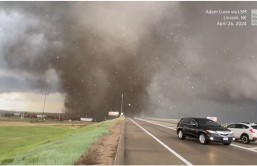The Draconid meteor shower will make a grand appearance this evening.
This meteor shower is not the biggest or the brightest, but it happens right after sunset which can spare a sky gazer the woes of getting up in the wee hours of the morning, USA Today reported.
The shower pops up every Oct., it occurs naturally from the "ribbon of space dust" left behind by the comet Giacobini-Zinner, the Los Angeles Times reported. The comet travels around the Earth once every 6 ½ years, and the meteor shower occurs when the Earth passes through the dust.
The meteor shower has proven to be disappointing in the past, some stargazers have reported only three or four stars and hour. If we're lucky, this year the Earth will hit a thicker cloud of dust that will produce a more thrilling show.
In 2011 the peak of the shower boasted 660 meteors per hour.
"Most years we just pass through gaps between filaments. ... Occasionally, though, we hit one nearly head on - and the fireworks begin," NASA's Bill Cooke told the Los Angeles Times back in 2011.
Meteor enthusiasts are hopeful for a good run this year because the moon is waxing, which will make the meteors even more visible, USA Today reported.
There could be some residual meteors spotted the next day, on Oct. 8, but the show will be significantly smaller.
In order to get the best view of the display one should get as far away from city lights as possible. It's also important to let the eyes adjust to the darkness for at least 20 minutes so the luight from the meteors will stand out.
"If you can see all of the stars in the Little Dipper, you have good dark-adapted vision," Rebecca Johnson, editor of StarDate magazine said, USA Today reported.
WATCH:








